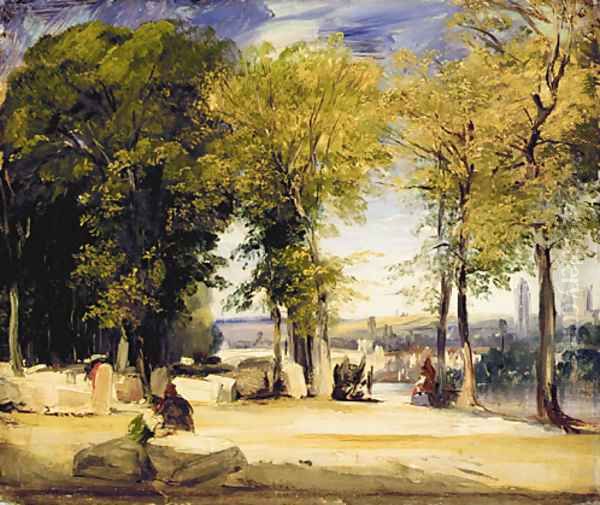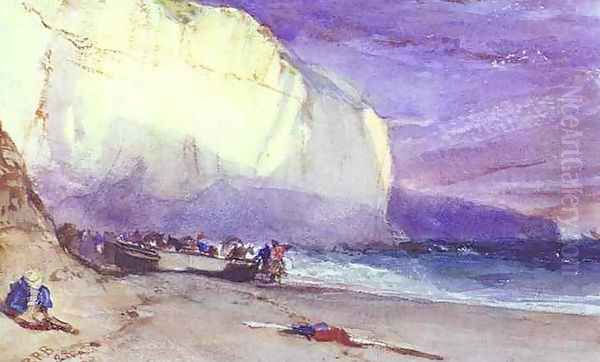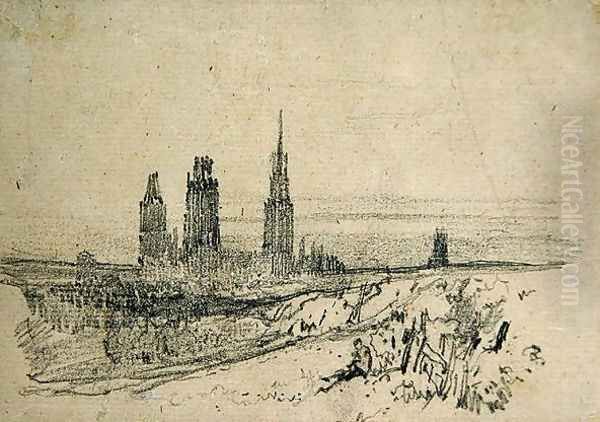
Richard Parkes Bonington stands as a remarkable figure in the annals of early 19th-century European art. An English painter whose career unfolded primarily in France, he became a pivotal conduit between the burgeoning Romantic landscape traditions of both nations. Despite a tragically short life, Bonington produced a body of work characterized by its luminosity, technical brilliance, and fresh observation of nature, leaving an indelible mark on contemporaries and successors alike. His mastery of watercolour and his innovative approach to oil painting secured him a unique place in art history, celebrated for capturing light and atmosphere with extraordinary sensitivity.
Early Life and Artistic Inclinations
Richard Parkes Bonington was born on October 25, 1802, in the village of Arnold, near Nottingham, England. He was the only child of Richard Bonington, a man of varied occupations including drawing master and, reportedly, sometime jailer, and Eleanor Parkes, who worked with lace. This artistic leaning within the family likely fostered the young Bonington's innate talents. From an early age, he displayed a clear aptitude for both art and performance. His precocity was evident when, at the remarkably young age of eleven, he had his watercolours exhibited at the Liverpool Academy, signalling the arrival of a promising new talent.
The economic shifts brought about by the Industrial Revolution significantly impacted the traditional industries of Nottingham, including textiles and lace-making. Seeking better prospects, the Bonington family made the decisive move to Calais, France, around 1817. There, Bonington's father established a lace factory, attempting to leverage his wife's skills and connections in the trade. This relocation proved crucial for the young artist's development, immersing him in a different cultural and artistic environment at a formative age.
French Training and Development

In Calais, the teenage Bonington's artistic education began in earnest. He started taking lessons in watercolour painting from François Louis Thomas Francia, a respected artist who had himself spent time in England and absorbed the influence of English watercolourists like Thomas Girtin. Under Francia's guidance, Bonington honed his skills in this demanding medium. Living by the coast, he developed a profound fascination with maritime subjects, coastal light, and the expansive skies of the Normandy region, themes that would recur throughout his career. His ability to rapidly capture the fleeting effects of weather and light in watercolour became a hallmark of his style.
Seeking more advanced training, Bonington moved to Paris around 1819 or 1820. He enrolled in the prestigious École des Beaux-Arts, joining the studio of Baron Antoine-Jean Gros. Gros, a pupil of the great Neoclassical painter Jacques-Louis David, was himself a complex figure, bridging the gap between Neoclassicism and the emerging Romantic movement, particularly known for his large-scale historical paintings and portraits. While Bonington absorbed the rigorous academic training offered, his own inclinations leaned more towards landscape and a more immediate, less formalized approach than that favoured by the Neoclassical tradition represented by David.
Parisian Connections: Delacroix and Constable's Impact
Paris proved to be a stimulating environment for Bonington. He spent time studying the Old Masters in the Louvre, absorbing lessons from Dutch and Flemish landscape painters as well as Venetian colourists. Crucially, it was in Paris, possibly within Gros's studio or the wider artistic circles, that Bonington met and formed a deep, enduring friendship with Eugène Delacroix, who would become the leading figure of French Romantic painting. This friendship was artistically synergistic, marked by mutual admiration and influence.
Delacroix was captivated by Bonington's technical facility, particularly his mastery of watercolour and his ability to achieve effects of light and spontaneity that Delacroix himself sought. He admired the "lightness of touch" and the "diamond-like sparkle" he perceived in Bonington's work, even if he occasionally felt it lacked the profound colour sensitivity he aimed for in his own art. They shared a fascination with historical subjects, particularly those with a medieval or Renaissance flavour, contributing to the "Troubadour style" popular at the time.
The year 1824 was significant. John Constable, the great English landscape painter, exhibited several works, including "The Hay Wain," at the Paris Salon. These paintings caused a sensation with their fresh, naturalistic approach, their vigorous brushwork, and their depiction of atmospheric effects. Bonington, along with Delacroix, studied Constable's work closely. While Bonington's style was already developing along lines of naturalistic observation, Constable's example likely reinforced his commitment to capturing the specific qualities of light and weather and may have encouraged greater boldness in his oil painting technique.
A Flourishing Style: Watercolour and Oil

Bonington is perhaps most celebrated for his watercolours. He possessed an almost unparalleled ability to handle the medium with fluency and brilliance. His technique often involved working quickly, sometimes on damp paper (wet-on-wet), allowing colours to blend softly while retaining a sparkling transparency. He achieved effects of light on water, vast, cloud-filled skies, and delicate atmospheric haze with apparent effortlessness. This technical virtuosity was not merely for show; it served his aim of capturing the immediate sensation of being in the landscape, prefiguring the concerns of later plein air painters.
While watercolour remained central, Bonington also became a highly accomplished oil painter. His experience with watercolour profoundly informed his approach to oils. He often maintained a similar fluidity and transparency, applying paint in thin layers (glazes) and using lively brushwork to convey texture and light. His canvases, whether depicting coastal views, river landscapes, or city scenes, are characterized by their luminous quality, often featuring low horizons that emphasize dramatic, light-filled skies. He managed to combine the detailed observation associated with the Northern European tradition with a broader, more atmospheric handling inspired by painters like Claude Lorrain and his English contemporary J.M.W. Turner.
Travels and Subject Matter
Bonington's art was fuelled by his travels. The Normandy coast, near Calais and later Le Havre and Rouen, provided endless inspiration with its beaches, cliffs, harbours, and fishing communities. Works like A Scene on the North Coast of France (also known as A French River Mouth) exemplify his fascination with these subjects, capturing the interplay of water, sky, and human activity. He frequently painted views along the Seine, such as the serene On the Seine – Morning.
In 1825, Bonington travelled to London, accompanied by Delacroix and another artist friend, Alexandre-Marie Colin. This trip allowed Delacroix to experience England firsthand, while Bonington reconnected with his native country. They explored historical sites and absorbed British art, further enriching their shared interest in historical themes and costume, which found expression in small-scale historical genre scenes.
A pivotal journey occurred in 1826 when Bonington travelled to Italy, spending significant time in Venice. The city's unique combination of architecture, water, and light captivated him, resulting in some of his most famous works. Paintings like The Grand Canal, Venice and An Evening in Venice showcase his ability to render the shimmering reflections, the grandeur of the buildings, and the specific atmosphere of the Venetian lagoon. He captured both the famous landmarks and quieter corners of the city with equal brilliance. His Italian journey also took him to other cities, including Naples, further broadening his repertoire of landscapes and architectural studies.
Recognition and Salon Success

Bonington's talent did not go unnoticed. He began exhibiting at the prestigious Paris Salon in 1822, where his watercolours immediately attracted positive attention, earning him a silver medal. His reputation grew rapidly in French artistic circles. The Salon of 1824 was a triumph not only for Constable but also for Bonington, who exhibited both oils and watercolours and was awarded a gold medal, alongside fellow Englishmen Constable and Copley Fielding. This recognition firmly established him as a leading figure among the younger generation of landscape painters.
His works were sought after by collectors in both France and Britain. He also engaged in printmaking, producing lithographs, sometimes based on his own drawings and sometimes collaborating with others or interpreting works by artists like François-Alexandre Pernot. These prints helped disseminate his images and style more widely. He also provided illustrations for books, further diversifying his artistic output.
Notable Works
Bonington's oeuvre, though produced over a mere decade, contains numerous masterpieces. Among his most celebrated works are:
On the Seine – Morning: A quintessential example of his ability to capture the tranquil light and atmosphere of a river landscape.
The Grand Canal, Venice: Demonstrates his mastery in depicting the complex interplay of architecture, water, and light in the iconic Venetian setting.
A Scene on the North Coast of France (or A French River Mouth): Captures the breezy atmosphere and daily life of the Normandy coast.
Fishmarket near Boulogne: A lively depiction of a coastal scene, showcasing his skill in rendering figures and textures within a landscape setting. There is some historical debate whether this specific work won a medal, but it remains a well-regarded painting.
View near Rouen: Highlights his interest in the picturesque qualities of French towns and river valleys.
La Ferté: An atmospheric landscape showcasing his typical low horizon and expansive sky, now housed in the National Gallery, London.
An Evening in Venice: A evocative portrayal of the city at dusk, emphasizing mood and colour.
These works, among many others, are characterized by their technical brilliance, sensitivity to light, and fresh, naturalistic vision.
Declining Health and Premature Death
Tragically, Bonington's burgeoning career was overshadowed by ill health. He suffered from tuberculosis, a disease rampant in the 19th century. His condition likely worsened due to his demanding work schedule and travels. Seeking respite or a cure, he travelled again to Italy and later, in 1828, to London for medical treatment. However, his health continued to decline rapidly.

Richard Parkes Bonington died in London on September 23, 1828, just a month before his 26th birthday. His death at such a young age cut short a career of extraordinary promise. He was initially buried at St James's Chapel in Pentonville, London. Later, in 1837, his remains were moved to the Kensal Green Cemetery, a more prominent resting place, reflecting his established reputation. Delacroix was deeply affected by the loss of his friend and artistic confidant.
Legacy and Influence
Despite the brevity of his career, Richard Parkes Bonington's influence was profound and far-reaching. He served as a crucial link between the landscape traditions of Britain and France at a time of significant artistic exchange. His technical innovations, particularly in watercolour, were admired and emulated. His fresh, direct approach to capturing nature, emphasizing light and atmosphere, resonated strongly with the Romantic sensibility.
In France, his impact was immediate. Delacroix openly acknowledged Bonington's influence on his own handling of landscape and light. Other French artists associated with the Romantic movement and the later Barbizon School, such as Paul Huet, Camille Roqueplan, and even the young Camille Corot, absorbed aspects of his style, particularly his atmospheric effects and fluid brushwork. His coastal scenes and luminous skies found echoes in their work. Thomas Shotter Boys, another English artist working in France, closely followed Bonington's style in watercolour and lithography.
Bonington's emphasis on direct observation and capturing fleeting effects can be seen as anticipating the concerns of the Impressionists. Artists like Claude Monet and Paul Cézanne, though belonging to a later generation, would have been aware of his work and the tradition he helped shape, particularly the move towards painting outdoors and prioritizing the optical sensations of light and colour.
In Britain, while perhaps overshadowed by the towering figures of Turner and Constable, Bonington remains a highly regarded figure, especially admired for his exquisite watercolours which stand comparison with the best practitioners of the medium, including Thomas Girtin. His work demonstrated that the English watercolour tradition could be adapted and revitalized through contact with continental trends.
Collections and Market Presence

Today, Bonington's works are held in major museum collections across the world. Significant holdings can be found in the UK at the National Gallery, Tate Britain, the Wallace Collection (which has a particularly fine group of his oils and watercolours), and the Victoria and Albert Museum in London, as well as regional galleries. In France, the Louvre holds important examples. In the United States, institutions like the Metropolitan Museum of Art in New York, the National Gallery of Art in Washington D.C., and the Yale Center for British Art possess notable works.
His paintings and watercolours continue to be highly sought after on the art market. Auction results demonstrate the enduring appreciation for his skill and rarity, with significant prices achieved for prime examples of his work, confirming his status as a major figure of the Romantic era.
Conclusion: A Fleeting Brilliance
Richard Parkes Bonington's life was tragically short, yet his artistic legacy is substantial. In just a decade of activity, he forged a unique style that blended English watercolour techniques with French Romantic sensibilities. His luminous landscapes, characterized by brilliant light effects, atmospheric depth, and technical fluency, captured the imagination of his contemporaries, including giants like Delacroix and Constable (whose influence he also absorbed). As a bridge between nations and a precursor to later movements, Bonington remains a vital figure in the story of European landscape painting, a testament to a dazzling talent extinguished far too soon. His work continues to enchant viewers with its freshness, elegance, and profound sensitivity to the natural world.